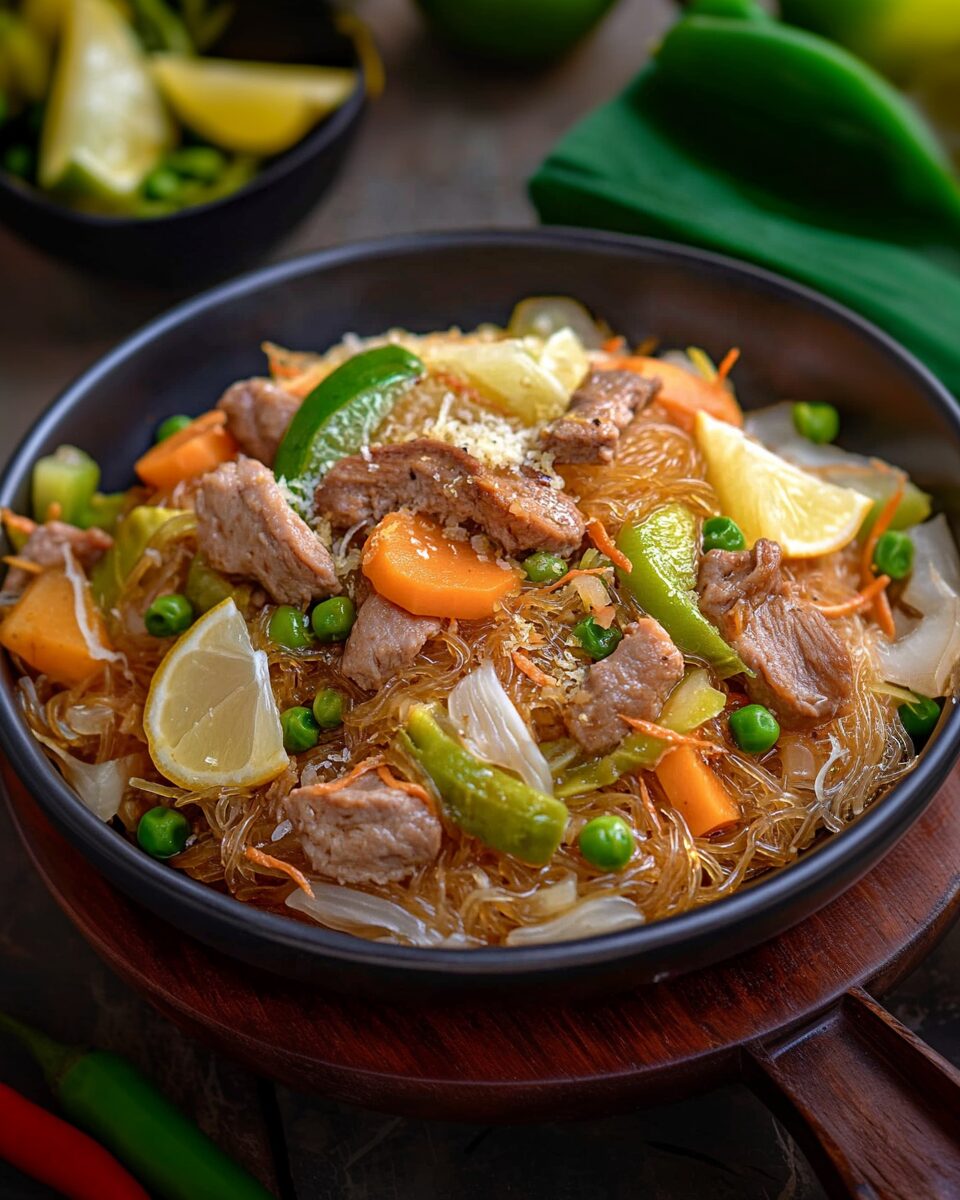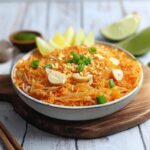Historical Origins of Pancit Guisado
Pancit Guisado is part of a broader category of dishes known as “pancit,” which covers a variety of noodle dishes in Filipino cuisine. The word “pancit” is derived from the Chinese term “pianzi,” which refers to noodles. The influence of Chinese settlers in the Philippines during the 17th century is widely recognized as the origin of many Filipino noodle dishes, including Pancit Guisado.
Over time, Filipinos began adapting these Chinese noodle dishes by adding local ingredients, creating unique versions suited to their tastes. Pancit Guisado, in particular, is thought to have originated as a fusion of Chinese stir-fried noodles and Filipino culinary influences. It became a popular dish due to its relatively simple preparation and ability to feed large groups, making it ideal for celebrations. The introduction of rice noodles, a staple in Filipino kitchens, further contributed to the widespread popularity of the dish.
While Pancit Guisado remains deeply rooted in Filipino culture, it has also undergone numerous adaptations across regions, with each Filipino province adding its own twist to the recipe. This adaptability is one of the reasons Pancit Guisado is such an enduring and beloved dish.
Cultural Significance of Pancit Guisado
Pancit Guisado, like many other Filipino dishes, holds symbolic significance. The dish is often served during birthdays as it symbolizes long life and good health. In Filipino tradition, the noodles in pancit are eaten without breaking them, symbolizing the hope for long life. This is why Pancit Guisado is frequently found at birthday celebrations, where it is considered a lucky dish that brings blessings to the celebrant and the guests.
Beyond birthdays, Pancit Guisado is also served during other major Filipino celebrations, such as Christmas, New Year, and weddings. It’s a dish that is versatile enough to be enjoyed in both formal settings and casual family meals. Filipinos love to share food, and Pancit Guisado’s ability to serve multiple people makes it an ideal communal dish. It’s not uncommon for family members and friends to gather around a large bowl of Pancit Guisado, sharing stories and laughter while savoring the delicious meal.
Aside from its association with birthdays and celebrations, Pancit Guisado also has a practical role in Filipino cuisine. It is a dish that can be made in large batches, allowing families to prepare meals ahead of time. The ingredients can be easily adjusted to suit the needs of the household, making it an affordable and practical option for feeding large groups. Whether it’s served at a festive gathering or a casual lunch with family, Pancit Guisado brings people together in the spirit of sharing and celebration.
Modern Variations of Pancit Guisado
While the traditional Pancit Guisado recipe remains a classic, many modern variations of the dish have emerged, allowing cooks to experiment with different ingredients and flavor profiles. Some versions of the dish incorporate shrimp, squid, or even beef, adding variety and richness to the meal. Vegetarians and vegans also have their own adaptations of Pancit Guisado, using tofu or mushrooms as a substitute for meat.
In recent years, there has been a growing interest in healthier alternatives to traditional Filipino dishes, and Pancit Guisado is no exception. Some cooks opt for brown rice noodles instead of white rice noodles, as they are higher in fiber and nutrients. Others may use less oil or swap traditional seasonings for low-sodium alternatives to create a lighter, healthier version of the dish without compromising flavor.
Despite these variations, the essence of Pancit Guisado remains the same: a satisfying, flavorful dish that brings people together. The combination of tender noodles, savory meat, and fresh vegetables continues to delight taste buds and create lasting memories. Whether served in its traditional form or with a modern twist, Pancit Guisado remains an integral part of Filipino culinary heritage.
Nutritional Value of Pancit Guisado
As with many Filipino dishes, Pancit Guisado is a well-rounded meal that combines carbohydrates, protein, and vegetables. The dish is primarily made from rice noodles, which provide a good source of energy through carbohydrates. The addition of meat, whether it’s pork, chicken, or shrimp, contributes a rich protein source, essential for muscle growth and repair. Vegetables like carrots, cabbage, and snow peas not only enhance the dish’s flavor but also offer a variety of vitamins, minerals, and fiber.
The dish also provides a good amount of dietary fiber, particularly from the vegetables, which aids in digestion and promotes overall health. However, it’s important to note that Pancit Guisado can be high in sodium due to the use of soy sauce and chicken powder or bouillon. If you’re watching your sodium intake, you can reduce the amount of soy sauce or opt for low-sodium alternatives.
Additionally, Pancit Guisado contains a moderate amount of fat, especially if cooked with oil and fatty cuts of meat. While the dish is satisfying and filling, it is best enjoyed in moderation as part of a balanced diet.
Pancit Guisado: A Dish for Every Occasion
One of the reasons Pancit Guisado remains so beloved is its adaptability. The dish can be served for a wide variety of occasions, whether it’s a festive gathering or a simple family meal. It’s perfect for birthdays, New Year’s celebrations, and other milestones, but it also works as a comforting lunch or dinner on any given day. The dish’s versatility means that it can be easily adapted to suit different preferences and dietary restrictions, making it a great option for anyone.
Pancit Guisado also serves as a reminder of the importance of food in Filipino culture. In Filipino families, sharing meals is not just about nourishing the body but also about fostering connections, celebrating life, and creating lasting memories. The act of preparing and sharing Pancit Guisado brings people together in the spirit of love, warmth, and joy.
Conclusion
Pancit Guisado is much more than just a delicious noodle dish; it’s a symbol of Filipino culture, tradition, and togetherness. From its historical origins to its cultural significance, this dish has stood the test of time and remains a beloved part of Filipino cuisine. Whether enjoyed at a grand celebration or a humble family meal, Pancit Guisado brings people together to share in the joy of good food and great company.






